BIRTHDAY OF ST. MARY
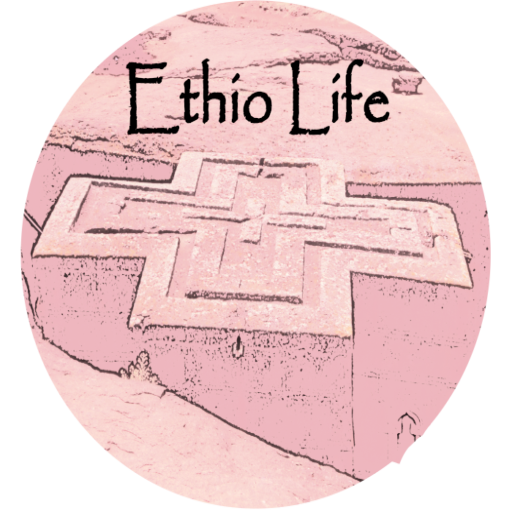
ETHIOPIAN CHRISTMAS CEREMONY

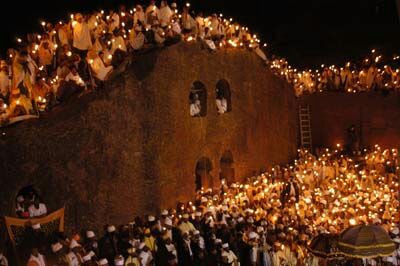
Genna ገና at Lalibela, (January 7)
Among the major feasts which are associated with Jesus and observed by the Ethiopian Orthodox church, the incarnation of nativity, Genna or Ethiopian Christmas is one of the highly celebrated feasts. The annual celebration of Genna on Tahisas 29 (January 7) commemorates the birthday of Christ. It is also the break of the fasting period, usually known as Tsoma Nebiat (fasting of the Prophets).
In the town of Lalibela, the colorful celebration of Genna coincides with the birthday of King Lalibela, who took the credit for the construction of 11 rock hewn churches approximately 900 years ago. While celebrating Genna at Lalibela, the clergy venerate the miraculous events which occurred when Jesus was born in Bethlehem. Angels and herds praised God at the same time when Jesus was born at Bethlehem. The clergy commemorate this incident at the cliff of Beta Mariam Church (one of the eleven rock hewn churches in the enclosure). They do so by performing the hymn, half being at the top of the cliff and the remaining half at the bottom. While the clergy at the top of the cliff symbolizes the angels, those at the bottom represent the herds.
Lalibela and its 11 rock hewn churches will be filled with vast amount of pilgrims who come from all directions of Ethiopia and from all walks of life. Most of the pilgrims reach at St. Lalibela from far off hamlets and inaccessible valleys, walking on their bare feet for days, weeks, and even for months to share the blessing of Christmas day. Even if Ethiopian Christmas is on January 7, there will be different ceremonies to be held around the rock-hewn churches starting the night of 4th January.
On the night before January 7th the pilgrims jam the church of Beta Mariam, a church dedicated to Virgin Mary, shoulder to shoulder and swarm the surrounding hills. To begin the Mass, priests chant and rattle sistras, palm-size instruments from Old Testament times and the celebrations continue throughout the night.
At sunrise, the church is emptied. More than 100 priests climb the rocky steps to the rim of the pit overlooking the church and form a line that snake to the very edge of the drop. They wear white turbans, carry golden scarves and adorned with red sashes stitched into the hems of their white robes. Several deacons begin beating large drums, and the priests begin to sway in unison, rattling their sistras, then crouching in a wavy line to the beat and rising again, this is a reference to King David’s dance the last of the Christmas ceremonies. It is an ancient Christian tradition which has remained unchanged and witnessing this event, you feel like you are transported centuries and centuries back in time.
TIMKET FESTIVAL
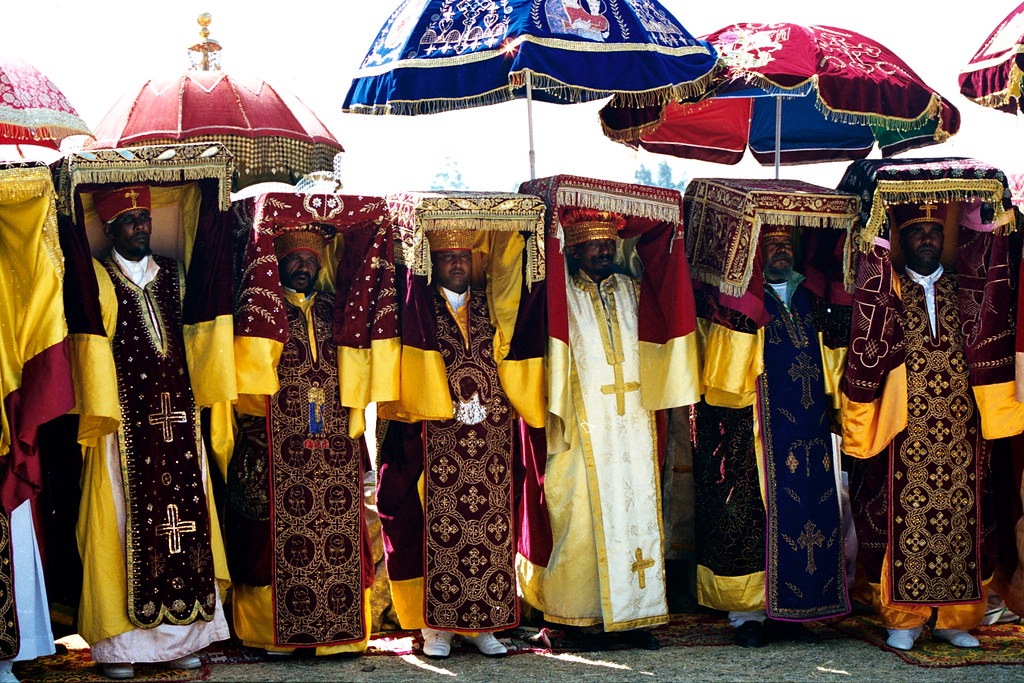
The Epiphany (January 19)
The festival of Timket falls on Tirr 11(January19) every year. It is observed in commemoration of Jesus Christ’s baptism in River Jordan. The celebration of Timket starts on the eve of the main festival. The eve is known as ’Ketera’ and taken from the Amharic word ‘ketere’ meaning to make a dam; it is usual to make a dam in some places where there is no enough river water for the celebration of Timket.
In the afternoon of Ketera the tabots (holy Arks) from each of the churches are taken to a significant water body. Accompanied by a great ceremony, each tabot is carried overhead by a high priest. It is taken to spend the night there, an activity that helps in performing the timket ceremony, usually done early in the morning the time Jesus Christ was baptized. The ceremony extends throughout the night and the next day early in the morning the Timket celebration start. The ceremony begins with the pre-sun rise rituals which include the Kidane (Morning Prayer) and the Kidasie (the divine clergy). These rituals are followed by the blessing and sprinkling of the blessed water on the assembled congregation in commemoration of Christ’s baptism.
According to the interpretation of the Ethiopian Church, the term Timket is taken from the Ge’ez word Asteryo meaning “reveal”. This meaning is associated with the revelation of the trinity, or the unity of God the father, the son, and the Holy Ghost during the baptism of Christ. In Greek language, the word “baptism” refers to immersion in water, thus Christ himself was baptized by being immersed in water, river Jordan. Consequently, Timket is supposed to be performed by immersion in a body of water. But, in most cases, priests usually sprinkle the blessed water over the congregation, except in few cases where a larger pool is available immersion or to swimming like that of the bathing Palace Fasiledes in Gondar.
At about 10 or 11am, each tabot begins the journey back to its respective church. This involves an even more colorful ceremony with a variety of traditional and religious songs. The priests wear astonishing brocade ceremonial clothes and carry decorated umbrellas, while chanting to the accomplishment of drums and the rhythmic clink of the sistrum and other instruments. Although it is colorfully celebrated throughout the country, Timket is highly regarded in Addis Abeba, Lalibela and Gondar.
In Gondar, the bathing palace of Fasiledas is still dedicated to this colorful ceremony. It is still filled with water each year by a canal from the River Keha for the colorful Timket celebration. Besides the baptism of Jesus Christ, the celebration of Timket in Gondar also commemorates the re-baptizing of thousands of people who have converted from Catholicism to the Orthodox faith. Even though Gondar can be visited at anytime of the year, the city is a wonderful place of visit during this season as it gives one a chance to witness the colorful ceremonies of the timket Festival.
In Addis Ababa, Jan Meda is the ideal place of witnessing the colorful celebration of Timket. In Lalibela it is equally celebrated like that of Christmas with relatively less crowd-situations of the flocking pilgrims. Traditionally, Timket was known as an important occasion for young adults to choose the would-be lovers.
MESKEL CEREMONY
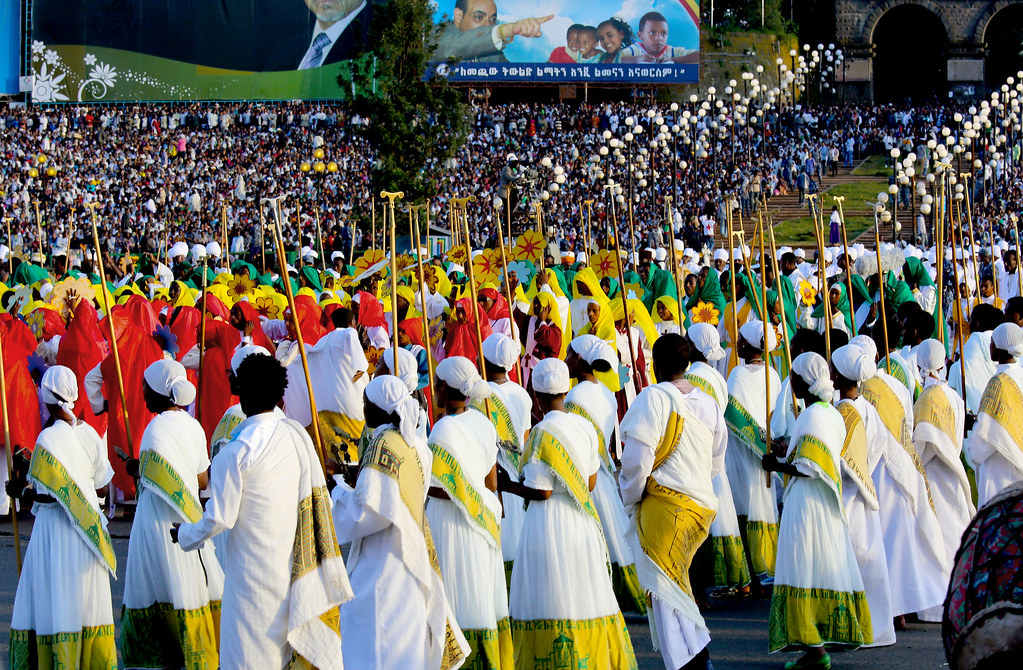
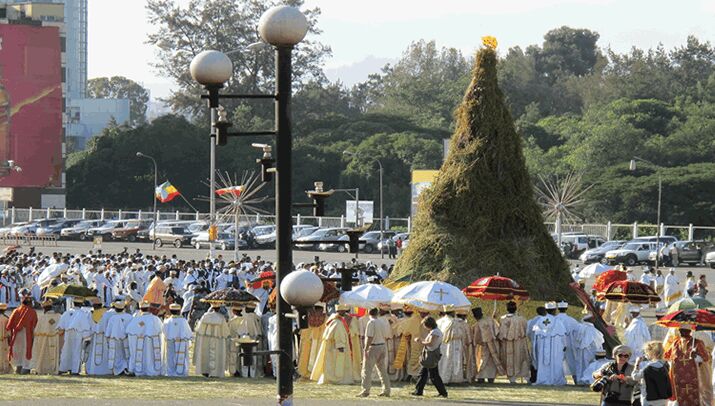
Finding of the True Cross (September 27)
Meskel is second in importance only to Timkat and has been celebrated in the country for over 1,600 years. The word actually means “cross” and the feast commemorates the discovery of the Cross–upon which Jesus was crucified–by the Empress Helena, the mother of Constantine the Great. The original event took place on 19 March, AD 326, but the feast is now celebrated on 27 September.
Many of the rites observed throughout the festival are said to be directly connected to the legend of Empress Helena. On the eve of Meskel tall ranches are tied together and yellow daisies, popularly called meskel flowers, are placed at the top. During the night these ranches are gathered together in front of the compound gates and ignited. This symbolizes the actions of the Empress who, when no one would show her the Holy Sepulcher, lit incense and prayed for help. Where the smoke drifted she dug and found three crosses. To one of the them, the True Cross, many miracles were attributed.
Meskel also signifies the physical presence of the True Cross at the remote mountain monastery of Gishen Mariam located in the Welo region. In this monastery is a massive volume called the Tefut, written during the reign of Zera Yacob (1434-1468), which records the story of how a fragment of the Cross was acquired. In the Middle Ages, it relates, the Christian monarchs of Ethiopia were called upon to protect the Coptic minorities and wage punitive war against their persecutors. Their reward was usually gold, but instead the Emperor Dawit asked for a fragment of the True Cross from the Patriarch of Alexandria. He received it at Meskel.
Enkutatash

The Ethiopian New Year (September 11)
The Ethiopian calendar registers the New Year on Meskerem (September); first, as a commemoration of the receding of the great storm during the time of Noah and secondly as a remembrance of Kidus Yohannes, (St. John the Baptist) beheading. Hence, the Ethiopian new year is also known as Kidus Yohannes, in memory of the saint and his sacrifice. All these symbolize the transition from the Old Testament to New Testament. The Ethiopian New Year also honours’ the seasonal transition from the heavy rainy season to the bright one. The safe transition from the rainy season to the breathtaking bright Meskerem is symbolic of the passage from an awe inspiring night into a beautiful morning. Thus, believers celebrate it with first Enkutatash and then Meskal holidays. The prior season is grey and dull, and is awe-inspiring and often frightening, with lightning and thunder accompanied by powerful rains for a lengthy period. Traditionally, it was believed that death was at hand during this season time, and so insecurity and fear ran rampant. The clergymen sing about the dawning of Meskerem because they consider the preceding rainy season a season of darkness.
Within the Ethiopian Orthodox Tewahido Church, many religious services accompany Enkutatash. Liturgical services such as the chanting, preaching, and the explanation of the New Year calendar are performed after the mass when is conducted in the morning, and before the mass, when the mass is conducted in the afternoon. After the chanting and preaching, the high priest or the Aleka (head) of each church reads the calendar of the Ethiopian Orthodox Church, which is called Bahre-Hassab.This indicates the times of the festivals, the beginning and end of the fasting days during that year. The same priest then declares the replacement of the old year by the new. Both Enkutatash and Meskal fall during the mass blooming of golden yellow Meskal daisies known as ‘adey ababa’. At the celebrations of Enkutatash and Meskal, children can be heard singing interesting traditional seasonal songs. “Eyoha abebaye / Meskerem tebaye / Meskerem siteba adey sifeneda/ Enkuan sew zemedu yieteykal bada…..” roughly translated as “the bright season of September with the fields decorated with blooming flowers encourage people to visit not only kinsmen friends….” These words announce the coming of the bright Ethiopian month with its colorful flowers. The song also encourages everybody to pay a visit to his or her relatives, because the now-receding rivers make it easier for people to travel from place to place. The best time of visiting Ethiopia is impeccably this time of the year.
Etymologists relate Enkutatash to the visit of the queen of Sheba to King Solomon of Israel. This new New Year celebration as a national holiday is celebrated both by Muslims and Christians.